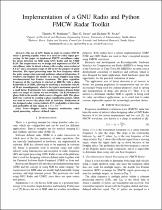JavaScript is disabled for your browser. Some features of this site may not work without it.
- ResearchSpace
- →
- Research Publications/Outputs
- →
- Conference Publications
- →
- View Item
| dc.contributor.author |
Mathumo, TW

|
|
| dc.contributor.author |
Swart, TG

|
|
| dc.contributor.author |
Focke, Richard W

|
|
| dc.date.accessioned | 2018-08-24T09:39:58Z | |
| dc.date.available | 2018-08-24T09:39:58Z | |
| dc.date.issued | 2017-09 | |
| dc.identifier.citation | Mathumo, TW, Swart, TG and Focke, RW. 2017. Implementation of a GNU radio and python FMCW radar toolkit. IEEE AFRICON, 18-20 September 2017, Cape Town, South Africa, pp 585-590. | en_US |
| dc.identifier.isbn | 978-1-5386-2775-4 | |
| dc.identifier.isbn | 978-1-5386-2776-1 | |
| dc.identifier.issn | 2153-0033 | |
| dc.identifier.uri | http://ieeexplore.ieee.org/document/8095547/ | |
| dc.identifier.uri | http://hdl.handle.net/10204/10393 | |
| dc.description | Copyright: 2017 IEEE. Due to copyright restrictions, the attached PDF file contains the accepted version of the published item. For access to the published version, kindly consult the publisher's website. | en_US |
| dc.description.abstract | The use of GNU Radio in order to explore FMCW radar is growing rapidly, where it is used for radar signal processing. In this paper we implement FMCW surveillance radar for drone detection on SDR using GNU Radio and the USRP B210. The requirement was to design and implement an FMCW surveillance radar to detect a drone with a radar cross-section of 0.1 m2 and a maximum range of 150 m for the purpose of point detection. The signal processing takes the beat frequency which has pulse compression gain and performs coherent integration. It windows and displays the results on a range Doppler map using two-dimensional fast Fourier transform. The pulse repetition frequency of the waveform is selected as 2200 Hz with a chirp bandwidth of 28 MHz, allowing for resolving a maximum velocity of 30 m/s unambiguously, which is the typical maximum speed of a small drone. Experiments were conducted using a human being and a car target as a drone was not available. The B210 induced a phase drift in the results which causes a Doppler shift. The phase drift was resolved by creating a phase equalization matrix, which was used to correct the phase drift in real-time. Verification of the designed radar system yielded a 63% probability of detection and probability of false alarm of 1.7 × 10-6. | en_US |
| dc.language.iso | en | en_US |
| dc.publisher | IEEE | en_US |
| dc.relation.ispartofseries | Worklist;20620 | |
| dc.subject | GNU Radio | en_US |
| dc.subject | Radar signal processing | en_US |
| dc.subject | Surveillance radar | en_US |
| dc.title | Implementation of a GNU radio and python FMCW radar toolkit | en_US |
| dc.type | Conference Presentation | en_US |
| dc.identifier.apacitation | Mathumo, T., Swart, T., & Focke, R. W. (2017). Implementation of a GNU radio and python FMCW radar toolkit. IEEE. http://hdl.handle.net/10204/10393 | en_ZA |
| dc.identifier.chicagocitation | Mathumo, TW, TG Swart, and Richard W Focke. "Implementation of a GNU radio and python FMCW radar toolkit." (2017): http://hdl.handle.net/10204/10393 | en_ZA |
| dc.identifier.vancouvercitation | Mathumo T, Swart T, Focke RW, Implementation of a GNU radio and python FMCW radar toolkit; IEEE; 2017. http://hdl.handle.net/10204/10393 . | en_ZA |
| dc.identifier.ris | TY - Conference Presentation AU - Mathumo, TW AU - Swart, TG AU - Focke, Richard W AB - The use of GNU Radio in order to explore FMCW radar is growing rapidly, where it is used for radar signal processing. In this paper we implement FMCW surveillance radar for drone detection on SDR using GNU Radio and the USRP B210. The requirement was to design and implement an FMCW surveillance radar to detect a drone with a radar cross-section of 0.1 m2 and a maximum range of 150 m for the purpose of point detection. The signal processing takes the beat frequency which has pulse compression gain and performs coherent integration. It windows and displays the results on a range Doppler map using two-dimensional fast Fourier transform. The pulse repetition frequency of the waveform is selected as 2200 Hz with a chirp bandwidth of 28 MHz, allowing for resolving a maximum velocity of 30 m/s unambiguously, which is the typical maximum speed of a small drone. Experiments were conducted using a human being and a car target as a drone was not available. The B210 induced a phase drift in the results which causes a Doppler shift. The phase drift was resolved by creating a phase equalization matrix, which was used to correct the phase drift in real-time. Verification of the designed radar system yielded a 63% probability of detection and probability of false alarm of 1.7 × 10-6. DA - 2017-09 DB - ResearchSpace DP - CSIR KW - GNU Radio KW - Radar signal processing KW - Surveillance radar LK - https://researchspace.csir.co.za PY - 2017 SM - 978-1-5386-2775-4 SM - 978-1-5386-2776-1 SM - 2153-0033 T1 - Implementation of a GNU radio and python FMCW radar toolkit TI - Implementation of a GNU radio and python FMCW radar toolkit UR - http://hdl.handle.net/10204/10393 ER - | en_ZA |






